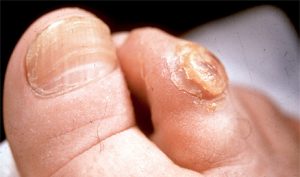
Corns are areas of thickened skin that can develop on your feet and toes due to repeated pressure or friction. There are several factors that can contribute to developing corns on your feet including:
- repetitive activities
- shoes that don’t fit you properly
- foot conditions like bunions or hammer toe
There are different types of corns, including:
- hard corns
- soft corns
- seed corns
Seed corns are small corns that can appear on the soles of your feet. They can sometimes be difficult to tell apart from other foot lesions, such as calluses and plantar warts.
Continue reading to learn more about seed corns, how they’re treated, and how you can tell them apart from other foot lesions.
What is a seed corn?
A seed corn is a tiny type of foot corn. Like other types of corns, they may develop due to pressure and friction. Seed corns are also associated with dry skin. The medical term for seed corns is heloma milliare.
Some other qualities of seed corns are that they’re:
- hard, well-defined, circular spots of skin that are smaller than other types of corns
- found on the sole (bottom) of your foot, typically in multiples
- often asymptomatic, but can cause discomfort or pain when pressure is applied or when they occur in weight-bearing areas
What’s the difference between a seed corn and a callus?
Calluses are also hard areas of thickened skin that can appear due to prolonged friction or pressure. They can be very similar in appearance to corns.
Some ways to help distinguish a callus from a corn include:
- Size. Calluses are typically larger than corns, especially seed corns.
- Shape. While seed corns (and other types of corns) are typically round and well-defined, calluses can vary greatly in shape.
- Location. Calluses more often appear in the areas of your feet that bear weight, such as around your heel or the ball of the foot.
- Pain. It’s rare for a callus to be painful. However, if the skin of a callus becomes cracked, pain may occur.
How is a seed corn treated?
If you have seed corns on your feet, you can do the following things at home to treat them:
- Reduce thickened skin. There are some steps that you can take to thin your skin that has thickened due to seed corns:
- Filing. You can use a pumice stone or emery board to gradually file away layers of thick skin. Be sure to do this gently and not to file away too much skin to avoid injury.
- Over-the-counter medications. These products contain salicylic acid. They’re available as liquids or pads. Avoid using these if you have diabetes or another condition that affects blood flow.
- Soak your feet. Soaking your feet in warm, soapy water for 5 to 10 minutes softens seed corns. This makes them easier to remove.
- Moisturize. Apply a moisturizer to the soles of your feet to hydrate and soften your skin.
- Consider footwear. While treating your seed corns, aim to wear comfortable and fitting socks and shoes.
Seed corns can eventually go away with at-home care. The amount of time this may take can vary by individual.
In situations where seed corns are persistent or don’t go away using the above methods, they can be should be treated by a Podiatrist. Never try to do this yourself, as it could lead to an infection.
How can you prevent seed corns from forming?
You can do the following things to help keep seed corns from forming or reappearing:
- Choose shoes carefully. Ill-fitting shoes are a common cause of corns. When selecting shoes, aim for the following:
- A good fit. Make sure that your shoes fit well. For example, check that your foot doesn’t slide back and forth in them when you walk or that seams, or stitches don’t press too much on parts of your feet.
- Plenty of toe room. If you can’t comfortably wiggle your toes, a shoe is probably too tight.
- A low heel. High heeled shoes apply additional pressure to your feet.
- Wear socks. Wearing socks with your shoes can help reduce friction on your feet.
- Moisturize. Seed corns are associated with dry skin, so try to moisturize the bottoms of your feet regularly.
- Consider pads or inserts. Using stick-on pads or removable shoe inserts can help to ease pressure and friction on specific areas of your feet.
When should you seek Podiatry help?
Make an appointment with your Podiatrist if you have seed corns that are:
- very painful
- interfering significantly with your daily activities
- inflamed or appear infected
People with diabetes or another health condition that impacts blood flow in the feet are at a higher risk of infection due to minor injuries from self-treatment.
In that case, be sure to contact your doctor before trying to treat seed corns yourself.
Most of the time, a doctor can diagnose seed corns through a simple examination of your feet.
Takeaway
Seed corns are a tiny type of corn that can develop on the soles of your feet and often occur in groups. They typically don’t cause symptoms unless pressure is applied to them.
Calluses and plantar warts can often appear very similar to seed corns. However, you can use characteristics like size and appearance to tell these different skin lesions apart.
Seed corns can be treated at home by:
- thinning skin that’s become thickened
- soaking your feet
- moisturizing
Contact your Resonance Podiatrist if your seed corns have become very painful or appear inflamed or infected.
Call us today to resolve your foot pain.
0800 473 776
(09) 212 9612
